This was the last ever newsletter on a site we outgrew. All the rest which follow were done on a new site and with an entirely new system, and the newsletters before were lost to the ether. However, whilst looking for something else on another computer I found he major parts of this all over again and decided to restore it though several cards were missing.
At the time I originally wrote the content, I made much of it being reborn like a Phoenix, bigger and brighter than before, and here I am rebirthing it all over again. Also at the time, I said that best of all it as going to be way easier for you all to take part in building it - for since the last time we all gathered together at an actual physical Cartophilic Convention, pre-covid and its restrictions - and I slid into this chair, it had just been me talking about things I like, but now perhaps i could join in with what you will be celebrating over the next months, and find out more about what your own card-worlds were like. And I am delighted to say that there has indeed been much more participation from our readers. So thank you all, very much. ….
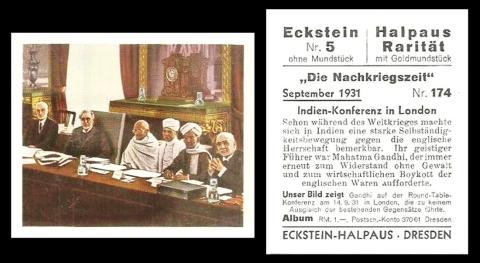
Eckstein-Halpaus [tobacco : O/S - Dresden, Germany] "Die Nachkriegszeit 1918-1934" / The Inter-War Period (1935) 174/252 - E165-550 : E10-8 : X24/15.A
On the 2nd of October, 1869, Mohandas Karamchand Gandhi – otherwise known as Mahatma Gandhi – was born into a Hindu family in Porbandar in India. His dreams sent him to England, studying law at the Inner Temple in London, and he qualified aged just twenty-two.
He then returned to India, but he found it much harder than he thought to get work. Somehow he heard of a case that involved an Indian merchant, in South Africa, and he relocated over there to represent the man, deciding to stay - perhaps because he liked it, and perhaps because the case brought him a little more into the public eye and he started getting work. He also met his future wife and started a family.
He stayed in South Africa for twenty-one years, and became more and more involved in politics, though he always believed in stating his case by non-violent means. This was to be his credo for the rest of his life, and in 1915, when he went back to India, he started to become involved in a series of campaigns for local people, farmers and labourers, as well as women, who were being heavily taxed and also discriminated against in other ways. Here too, he went about his protests in a peaceful manner, and became the leader of the Indian National Congress in 1921.
It was about this time that he began to change his dress, wearing simple clothing , like the rural and oppressed, with whom he felt most connected, and he also began fasting, which he used to concentrate his mind and also to protest against the maltreatment of his people. His most famous hunger strike was in 1948, when he was almost eighty, as a protest against the partitioning of India into sections by way of religion.
Though he was always non-violent, his actions, and also his regard amongst the people, led to him being arrested and imprisoned many, many times. And it also led to his assassination, aged seventy-eight, at a prayer meeting in Delhi on the 39th of January, 1948; a day which was chosen by the United Nations as The International Day of Non-Violence in 2007.
According to our friends at the trading card database, Gandhi appears on twenty-one cards from 1952 to 2015, and, as usual, varieties of the same set are counted as separate cards. However, actually there is a much earlier card of Gandhi, and that is the one we show you here. That dates from 1935 and it covers the Indian Conference in London which took place in September 1931 - or the second conference, anyway, which you can read about at the Open University 'Making Britain' website.
This card was actually issued in Germany, and covers the Post War Period (1918-1934); the title actually breaks down as Nach (after) Kriegs (war) Zeit (time), but there was an ulterior motive to the set as it traces the rise of Hitler and his political ideology, and was issued one year after he took office. The cards fit in to a hardback album of almost a hundred pages, which could be bought for just one Reichsmark - and as well as being issued by Zigarettenfabriken Eckstein-Halpaus of Dresden, you can also find it by Waldorf Astoria of Munich and Stuttgart. In fact we featured their version in our newsletter for the 4th of January 2025, though you will need to scroll down to Monday the 6th of January to see it.
This set first appears in our original World Tobacco Issues Index, along with a short heading about the company, which reads : "Amalgamated about 1930 of A.M. Eckstein & Sohne with Halpaus Cigarettenfabrik. German language issues, period 1930-42. Special albums issued."
Our set is described as :
- DIE NACHSKRIEGSZEIT (The Post War Period). Md. 62 x 52. Nd. (252). See X24/15.A ... E10-8
This text is identical in our updated version of this book, but without the "X" number, for that relates to the entry in the original handbook, which was at first a separate volume, but in later printings of the original World Tobacco Issues Index became combined therein. And that "X" entry reads :
- X24/15 DIE NACHSKRIEGSZEIT (The Post War Period). Medium size. 62 x 52. Numbered series of 252.
A. Eckstein-Halpaus
B. Waldorf-Astoria
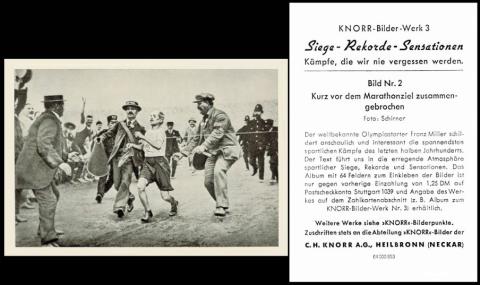
C. H. KNORR A.G. [trade : soups and seasonings : O/S - Neckar. Germany] "Siege, Rekorde, Sensationen" (1954) 2/64
Today sees a major sporting event return to the capital city, the Virgin Money London Marathon – which has been moved because of the pandemic.
The original Marathon is discussed as our Card of the Day for the 23rd of February 2025. The idea was remembered, and converted into a race for the first ever modern Olympic Games of 1896, and men have been running it ever since, though women were only given a chance to run the same length at the Los Angeles Olympics in 1984. That first Olympic marathon was actually of twenty-five miles, and it was won by a Greek water carrier called Spyridon Louis, with his countryman Charilaos Vasakilios coming home just eight minutes behind. However the Hungarian runner Gyula Kellner was only thirty-two seconds behind him in third place.
Marathons were also run in 1900 in Paris, won by Frenchman Michel Theato, and in 1904 in St. Louis, won by Thomas Hicks of the United States.
Our card shows the 1908 Olympic marathon, held at White City, and that was the first time that what would eventually become the standard distance of twenty-six miles, three hundred and eighty five yards was used - though it was not until the Paris Olympics of 1924 that it became the only distance ever to be used again. And what makes that even odder is that it was actually just the distance from the starting line at Windsor Castle to the Royal Box inside the White City Stadium, rather than any nod to the marathon run itself.
The 1908 Olympics were actually rather strange, not only because seventy five runners entered (reduced, thankfully, to a starting line up of fifty-five), but for the way it ended - and that is shown on this card, where we have Dorando Pietri, an Italian athlete, who had collapsed several times en route and then crossed the line at the end of the marathon, but only with assistance, before being disqualified for having been helped. Though it does say on card 1 of Quaker Oats` package issue "Great Moments in Sport" that he was "given a special gold cup by Queen Alexandra". And that turns out to be true, because a photograph exists!
That meant that the gold medal went to the American, John Joseph Hayes, who came home second, with a time of just under three hours. Now it is said that it was he who helped popularise the growth of marathons in cities, but this is incorrect, for the first city marathon was in Boston in 1897.
The first one in London, by the way, was in 1909 - that was called The Polytechnic Marathon, and it ran every year, using the standard Olympic distance but over a variety of courses. And it ran right until 1996.
Before we leave this subject, we must mention two important cards, both part of American Tobacco’s “Champion Athlete and Prize Fighter Series”, issued with Mecca Cigarettes in 1910. Series two included two Marathon runners - Harry Jensen (of the Pastime Athletic Club .. the amateur “Marathon King” having completed in and won more long races than any other amateur Marathoner.” His fastest time, as recorded on the card, was in the Yonkers Marathon on November 27, 2 hours 46 minutes and 43 1-5 seconds” - and Fred Meadows who “was in the Canadian Olympic Team to England in 1908 and it was after this that he began to show his best form”.
This set was designed to fit in a special album of thirty-six pages, split into sections for Athletics at the Olympic Games from 1896 to 1952, The greatest Boxing matches of all time, Giants of the Road, Motorsport, Fights in snow and ice, and Kings of Football.
As far as Carl Heinrich Knorr and his company, I cannot better the biography that has been pieced together by Unilever, who bought them out in October 2000. Suffice to say that the Knorr products remain a household name to this day.
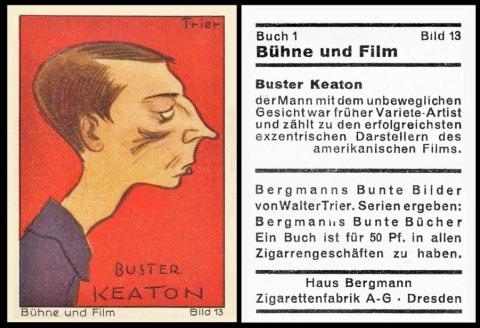
Haus Bergmann Zigarettenfabrik [tobacco : O/S : Germany] "Bergmann`s Bunte Bilder - Buhne und Film" / Stage and Film (1932) book 1 picture 13 - B317-100.1.2 : B60.1.2
Today, the 4th October, in 1895 was the birthday of Joseph Frank “Buster” Keaton.
His parents were vaudeville comedians who travelled around America with a group of other performers. One of these was Houdini, and reportedly it is he who we should thank for “Buster” Keaton, as he saw the small child falling down stairs and said the fall looked like it was a buster.
Houdini left the troupe but it continued for a few years. When it broke up Roscoe “Fatty” Arbuckle offered Buster Keaton a part in his new film “The Butcher Boy”. This was in 1917, and Buster Keaton was so grateful for the introduction into Hollywood that when scandal broke around Roscoe Arbuckle he stuck by him, gave him money when he ran short, found him jobs, and even offered to testify if required.
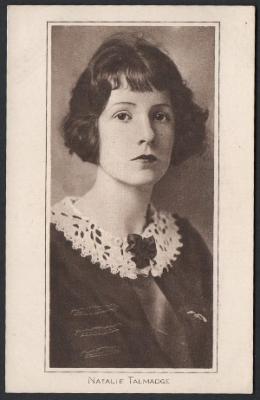
The same year Buster Keaton married Natalie Talmadge, as shown on this “Pictures Portrait Gallery” postcard. She was the youngest and least well known of the trio of Talmadge girls (Constance and Norma being the others) who were all popular actresses. Reportedly their parents were less than pleased with the marriage, thinking that he was only marrying into the great Talmadge family to ride their fame.
Despite this obstacle, the marriage was happy for a while, and they had two sons, but then things changed and she divorced him, rather acrimoniously in 1932, forbidding him to see the children or them to see him, dropping the Keaton from their double barrelled surname so they were only Talmadges, and also never hesitating in saying how bad a person he had been. There seems no firm idea of why this happened, sometimes it says that he was unfaithful, but what seems most telling is that after the two children she had decided not to have any more so had moved into separate quarters in the house. His career had going well, he had plenty of money, and he had been making two films a year, including many of the acrobatics that he had used on the vaudeville stage. One of these films, “The General” was about the American Civil War, and it featured a scene which was the most expensive sequence ever shot for motion pictures.
He married twice more, neither of whom were actresses. Then, in the 1940s, out of the blue, his children made contact, which pleased him very much, as did the fact that one became an actor, and took the name Buster Keaton Jr.
Buster Keaton Senior died on February 1, 1966. He was still making films to the end, his last one, “A Funny Thing Happened on the Way to the Forum” being released after his death, and he still did many of his own “stunts” in that movie, though his health was failing fast and a double did do the most dangerous or awkward of them.
Before we move along to the card, here is a warm and happy webpage for you to have a look at, and for cards, check out this list. However, that does not includeWills Cinema Stars Tobacco Cards, 3rd Series, (June 1931) which actually titles the film as “Forward March”, when it is more usually known as “Doughboys” – read more about that at IMDB.
Our card s were designed to fit in albums called "Bergmann`s Bunte Bucher" - Bucher meaning books. And they are in three groups, which are all listed with our home page for them all, our Card of the Day for the 16th of January, 2022. As this is but a link page, it only deals with our set, which appears in our original World Tobacco Issues Index as :
- 1. Buch 1 (100). 7 sub series, numbered from Bild 1 upwards
2. Buhne und Film (20)
The stars in the set are :
- Emil Jannings
- Marlene Dietrich
- Greta Garbo
- Hans Moser
- Dolly Haas
- Otto Wallburg
- Albert Bassermann
- Anny Ondra
- Adele Sandrock
- Willy Fritsch
- Heinrich George Buch
- Richard Tauber
- Buster Keaton
- Lilian Harvey
- Fritz Kortner
- Elisabeth Bergner
- Maurice Chevalier
- Hans Albers
- Charlie Chaplin
- Max Pallenberg
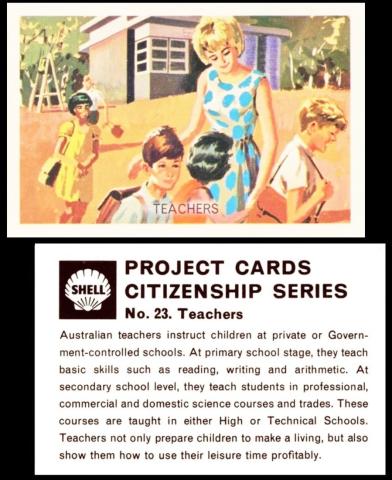
Shell [trade : petrol stations : O/S : Australia] “Project Cards – Citizenship Series” (1965) card 53 – SH6-3.1
World, or International Teachers Day, has been held every 5 October since 1994. This year the theme is “Teachers at the heart of education recovery”, and it pays tribute to the fact that throughout our battles with Covid the schools have remained open for children of caregivers and emergency workers, as well as provided meals and amusement for those who needed them. In this they deserve much more praise than the government will ever give them, for the teachers and staff were just as vulnerable to the disease, and for a long while it was not really known whether children were able to incubate it or even pass it on.
The earliest card of a teacher can be seen at the website of New York's Metropolitan Museum. This is from Goodwin & Co`s "Occupations for Women", an untitled and unnumbered series of 50 cards, also issued as a series of 24 by Cope, Cameron & Cameron, and Frishmuth, and as another set of 50 by Wm. G. Hills and Co Cigarerra Mexicana. Another version exists, by American Eagle, but look closely at those and you will see the bounders just pasted their name over Goodwin cards!
Teachers in movies, especially early ones, were looked upon rather humorously. Will Hay spent many years playing the Headmaster of St. Michaels, a series which had been running via radio since 1922, and can be seen as so on card 26 of the second series of Wills "Radio Celebrities". However there was an even earlier headmaster, portrayed by Cyril Maude in 1921 in a British silent comedy feature called "The Headmaster" - and that was based on a 1913 play of the same name by Edward Knoblock and Wilfred Coleby.
In addition you will find many schools shown on cigarette cards, really too many to name, but have a look through your collection and I am sure you will find one before too long.
This card fulfils the brief exactly, for it is a true International Teacher, all the way from Australia.
The home page for this entire group is with our Card of the Day for the 19th of March, 2024. Our set comes under group 1, "Issues in Australia - Inscribed "Shell" without full name", and is listed as :
- (a) Issues 1959-65. Nine sets numbered 1/540 except set SH6-3.1 which is numbered 1/60 instead of 421/480. Set SH6-2.2 was not actually issued, but remainders became available. Albums issued.
Project Cards. 76 x 51. Three sets of 60. ... SH6-3
2. Titled "Meteorology Series" Nd. 261/420
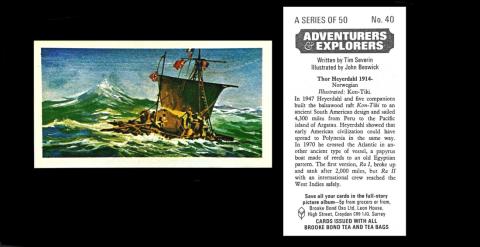
BROOKE Bond [trade : tea : UK - Croydon, Surrey] "Adventurers & Explorers" (1973) 40/50 - BRO-140 : BRM-46
On the 6th of October 1914, Thor Heyerdahl, explorer, anthropologist, film maker, author, and sailor was born in Norway. He is mostly remembered for three voyages using craft made of indigenous materials in which he attempted to prove that early civilisations could have once been connected.
Our card shows the first of these, the Kon-Tiki expedition of and the reverse tells us that him and five companions built this raft of balsawood to an ancient South American design and sailed 4,300 miles from Peru to the Pacific island of Argatau, showing that the early Americans could have spread to Polynesia in the same way.
In 1970, he crossed the Atlantic in another ancient type of vessel, a papyrus boat made of reeds to an old Egyptian pattern. This was Ra I which broke up and sank after 2,000 miles, but Ra II with an international crew managed to make its way to the West Indies.
Each of these were documented, and turned into films and books, and he also made a subsequent voyage on the Tigris. Sadly, although, as the Brooke Bond album even says, he “proved that it was possible” to make these voyages, sadly his work never gained the full acceptance of official bodies. However he did inspire many future explorers, and even impressed many land lubbers like me who wont even shower with the plug in because I might drown if I fall over. And you can read more about his life here.
This set has to wait until part three of our original British Trade Index, and then it is rather scantly described, as only :
- Adventurers & Explorers. Nd. (50). Issued 1973. ... BRM-46
And that text is repeated exactly in our updated British Trade Index, save a new card code, of BRO-140.
Something that is mentioned in neither is that there is actually an error card, No.33, showing Robert Edwin Peary, the American "Conqueror of the North Pole". The error concerns the last line of the reverse, the first version of which reads : "Peary was so determined to succeed that on the last lap of the journey he asked his Eskimos not waste effort by talking while they travelled". However there is a missing word here, it ought to read "...he asked his Eskimos not to waste effort by talking while they travelled." This card was therefore reprinted and re-issued. But it seems that the correct version is scarcer, maybe because the error was discovered late, when the set was already in most collectors hands.
Check your sets and see which you have
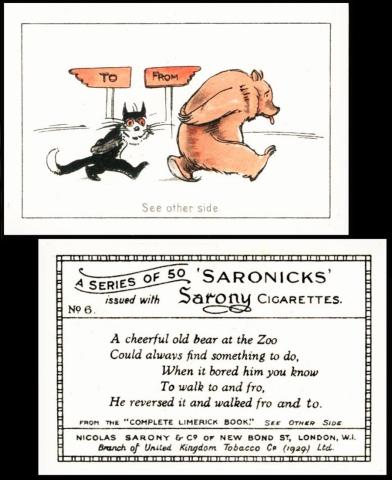
Nicolas SARONY & Co. [tobacco : UK - London W.1] "Saronicks" (June 1929) 6/50 - S111-580 : RB.113/414 : S26-15.B : Ha.557
Today being #NationalPoetryDay, we are going to go off on a bit of a tangent and talk about a different kind of poetry, the funny kind, not the thoughtful and introspective which is generally thought to be the norm. Though I have to say there is not a lot funny about a captive bear forced to walk with no chance of freedom or sight of the outside world in which he belongs. However, I must say that his little feline companion is rather akin to Felix the Cat, and I wonder if this was by design or accident.
Let us start with these, which have a kind of humorous cartoon on one side, though some of them do reflect the thoughts of the age and are rather unlikeable today. Then there is a limerick style verse on the other. This is more free verse, and it is true to say that many poets hone their skill on such things before writing longer and rhyming better.
But wait, for there is another curiosity about this set, which is hinted at in our original World Tobacco Issues Index. The entry for our set reads :
- `SARONICKS`. Nd. (50). See Ha.557 ... S26-15
A. Small, 63 x 36
B. Medium, 76 x 52
The Ha.557 reference leads us to the handbook which was uniform with the London Cigarette Card Company catalogue, and both published in July 1955. In there, all is revealed, as :
- Ha.557. "LIMERICKS" or "SARONICKS" (titked series). Front in colour. Numbered series of 50.
Drapkin - Titled "Limericks" - small size
A. White card
B. Cream card
Sarony - Titled "Saronicks" -
A. Small size
B. Medium size
As far as the catalogue, since they live next door to each other on my shelves, that lists the two sets as follows :
Major Drapkin & Co., London
- "Limericks" (June 1929).
A. White card - odds 2d. each, complete sets 10/-
B. Cream card - odds 2d. each, complete sets 10/-
and
Nicholas Sarony & Co., London
- "Saronicks" (June 1929).
A. Small size - odds 1/2d. each, complete sets 1/6.
B. Medium size - odds 1/2d. each, complete sets 1/6.
There is also a symbol by the Sarony version, which tells the buyer that "special offers on these sets appear in the Abridged catalogue".
In case you have not noticed, these two sets were indeed issued in the same month, June 1929. And here is our card in both formats, using the standard sized card not just for reasons of space, but because only Nicolas Sarony issued the larger sized version.

The reason for this is that by 1912 Major Drapkin was already advertising themselves as the proprietors of Sarony. Then Major Drapkin was bought out by Godfrey Phillips in 1931, and curiously after that date both companies were still in operation, but as being “under agreement and operating with Godfrey Phillips”. Then by 1946 both Major Drapkin & Co. and Nicholas Sarony & Co. were listed as being controlled by the United Kingdom Tobacco Company, along with Marcovitch & Co., and B. Muratti, Sons & Co.
By the time of our updated version of the World Tobacco Issues Index, this is made a little plainer. For one thing it clearly states in the header that Nicolas Sarony was a "Branch of the United Kingdom Tobacco Company". And our set is listed as :
- `SARONICKS`. Nd. (50). See RB.113/414 ... S111-580
A. Sm. 63 x 36
B. Md. 76 x 52
And that RB.113 code leads us the the updated reference book for Godfrey Phillips, where all the cards of all of their subsidiaries are now recorded.
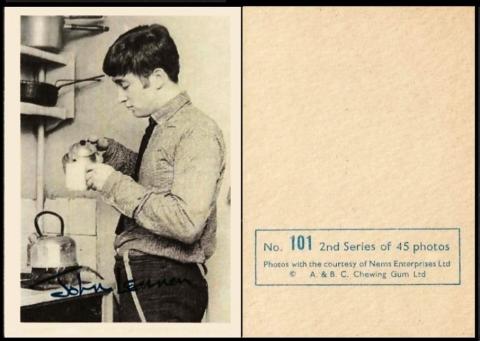
A. & B.C. Chewing Gum Ltd [trade : gum : UK] "The Beatles" - second series - card 101 - ABF-22.1.2
Can you imagine that it was all the way back on 8th October 1971 that John Lennon released one of the most memorable albums of all time, “Imagine”?
Now for anyone who does not know, John Lennon was not just a successful solo singer and political activist, he was also a Beatle – one of the world`s most popular groups, to this day, which originated in Liverpool. They were made up of John Lennon, Paul McCartney, George Harrison and Ringo Starr, as well as, briefly, Stuart Sutcliffe and Pete Best.
The best place to see a selection of Beatles cards online is mybeatles.net/cards. This site lets you click and browse five complete Beatles sets, including some, like ours, with facsimile autographs. However if you have a lot of time on your hands then look at the Trading Card Database, which has 463 cards just of John Lennon!
This set first appears in our British Trade Index part two, but in a rather curious way. The entry actually reads :
"POP STAR" GROUPING (A). 81 x 57. Back with blue rectangular panel at centre base inscribed "No. ... in a series of ... photos", "A & B.C." name below. ... ABF-22
- The Beatles. Back "Photos with the courtesy of Nems Enterprises Ltd.
1. "...series of 60 photos". Black with blue facsimile signature
2. "2nd series of 45 photos". Black with blue facsimile signature. Nd. 61/105
3. "...series of 40 photos". Coloured, no caption.
- The Rolling Stones (40) Coloured. All Rolling Stones caption.
- Top Stars (various groups). Coloured.
1. "... series of 40 photos"
2. "...series of 50 photos"
As for Nems Enterprises, this was a management company set up by Brian Epstein. The initials stood for "North End Music Stores", which was a record shop, attached to the Epstein family`s furniture store.
The company was set up in order to manage all artists signed to him, and there were two directors, Brian and Clive Epstein, who were brothers. Despite that it is known that most of the shares were held by Brian Epstein, some seventy per cent. His brother Clive had twenty per cent, and it is also known that the four Beatles, George Harrison, John Lennon, Paul McCartney and Richard Starkey (alias Ringo Starr) each had two and half per cent. It seems that the two and a half per cent was also given to other signings to the company, including but not to all.
This week's Cards of the Day...
This week our cards of the day have been associated with World Heart Day.
But for some reason a lot of them are in the wrong place, and all but two of them are repeats of next week about space. Fear not, somewhere I have the right cards and will work on restoring them and removing the space ones!
World Heart Day has taken place annually on the 29th of September ever since the year 2000, and though every year the theme alters, it always aims to convey the important message that though one in five people, across the globe, will meet an early death through cardiovascular disease, a great deal of those deaths are actually preventable, through having regular check ups and screenings, and keeping your body active, as well as eating the right kind of foods.
However, what is less known is that a quarter of those deaths are directly due to air pollution, which kills some seven million people every year, especially in larger cities.
Saturday, 25th September 2021

This club was simply formed by a few friends who had connections with the Heart of Midlothian Quadrille Assembly Club, a social and dance club in Edinburgh. It seems that some time in the 1870s some of the male members got a bit bored with the dancing and one of them brought a football with them, with which they adjourned to a local piece of open ground. At that time, of course, it was simply a kick about, with very improvised rules. We know that the group was in existence by December 1873 though, because in that month what is thought to be the first ever game of proper "Association" Football was held in Edinburgh, and after that our little group adopted many of the rules, and also gave themselves a team name, "Heart of Midlothian", reportedly after Sir Walter Scott`s novel - though there was also a cricket club, to which some of the members also belonged, and that was already called by the same name.
In 1875, the team believed themselves good enough to apply to join the Scottish Football Association, and they were accepted. In fact they made the final of the Scottish Cup later in the same year, against a team fielded by the third Edinburgh Rifle Volunteers. It ended in a goal-less draw, as did the rematch. There was controversy in 1884, after they won the Scottish Cup against Dunfermline with the massive rout of 11 goals to one - after which there were protests that their team included professional footballers. And they must have been, for they were suspended from the Scottish Football Association, for two years. After that, though, they returned, and won four cups between 1891 and 1906.
You can read their entire history at the club`s homepage, and it, too, is currently being updated with loving care.
The player in the inset is Jock White, who was born in Coatbridge on the 27th of August 1897 and not only played for Albion Rovers and Heart of Midlothian within his native Scotland, but also went across the border and played for Leeds United. His claim to fame was that in 1926, the year this card was issued, he had actually had a run of scoring four goals in three successive matches. And he also represented his Country, with the Scottish National Team.
His three brothers also played football at a similarly high level, Willie for Hamilton Academicals and Southampton - Tom for Heart of Midlothian and Alloa Athletic - and Jimmy for Albion Rovers, Motherwell, and also played in the United States, for the Marksmen, of New York.
"Boy`s Magazine" was published by Allied Newspapers Ltd, a British company which eventually had control of many local and national titles, including Amalgamated Press, which they acquired in 1926. But it started with two Welsh brothers, Gomer and William Berry, in 1915, buying out the Sunday Times. Along the way they met Edward Iliffe, who ran the Birmingham Post, the Birmingham Mail, the Cambridge Daily News and the Coventry Evening Telegraph
The first edition of "Boy`s Magazine" hit the newsstands on the 27th of February 1922, billed as a "New magazine of Sport and Adventure". It cost 2d. and was issued every Monday. And that first issue also included a free gift, which appears on the cover as "Art Plate of Famous Football Team Inside - suitable for framing."
As for our card, this is a most attractive set, very similar to Baines and often confused with them. Our original British Trade Index volume one, issued in 1962, catalogues it as :
- FAMOUS FOOTER CLUBS. Shaped and die cut. Blue, red and yellow. Dated 1926-7. Unnumbered. (21 known) ... BPM-4
Arsenal
Birmingham
Bolton Wanderers
Burnley
Cardiff City
Celtic
Chelsea
Clapton Orient
Everton
Fulham
Leeds United
Liverpool
Manchester City
Manchester United
Partick Thistle
Portsmouth
Preston N.E
Sheffield United
Spurs
Sunderland
Swansea
You will notice straight away that our card is not there. And it did not appear in the second volume either. In fact it took until the third volume to be added, as :
- BPM-4 (Famous Footer Clubs). Add Aston Villa, Heart of Midlothian, West Ham United.
When all these four volumes were collated, and formed into our updated British Trade Index, one volume and a handbook uniform, the entry had slightly changed. That reads :
- FAMOUS FOOTER CLUBS. 1926-27. Shaped and die cut. Blue, red and yellow. Unnd. (24). Issued two each week for 12 weeks. See HB-144. ... BOY-460.
Sunday, 26th September 2021
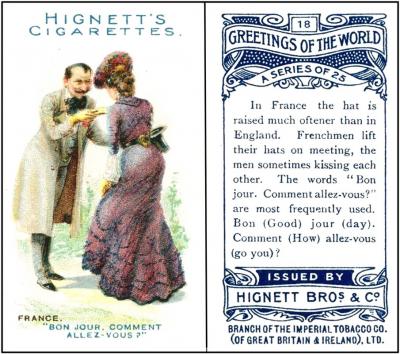
I have to say that when this set was reissued some of the costumes, like this one, must have looked very old fashioned when compared with the kind of “flapper” girls fashions that characterise the 1920s. I believe it was reissued because in 1922 cards were just starting to appear in packets and maybe Hignett had nothing ready; their previous set had been a military one, H536-130 [tobacco : UK] “Company Drill”, issued in September 1915, and the public had little taste for war in 1922, when the full horrors were starting to be revealed.
This was all before Hignett were incorporated into Ogdens and started issuing identical sets save the names, of course – that did not happen until 1930. This set is described in the London Cigarette Card Company part one catalogue covering 1888 – 1919 (issued in July 1955) as “Greetings of the World (Jan. 1907 – re-issued 1922). They do not appear in the 1920 – 1940 catalogue, therefore it is pretty certain I am right, and that they were using up old stocks of the same cards. By the way they are listed for sale in that catalogue at 6d, to 9d. per odd card and 17/6d a set.
Monday, 27th September 2021
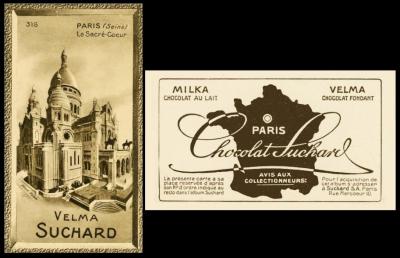
Here we have a church, called on the card "Le Sacre Coeur Paris", but actually having a much grander title, of "Le Basilique du Sacré-Cœur de Montmartre".
And it is dedicated to the Sacred Heart of Jesus.
However, you may not realise that it is a relatively modern one, and the idea was only suggested on September the 4th, 1870, by the Bishop of Nantes, in order to atone for the defeat of France and the capture of its Emperor, Napoleon III, by the Prussians.
The site, on high ground at Montmartre, was chosen so that the dome could be seen from almost anywhere in Paris - but also there were other factors, firstly that Montmartre means the "Hill of the Martyrs", and secondly, that it was there that the patron saint of Paris, St. Denis, was beheaded by the Romans, and later became the burial place for every King of France until the French Revolution.
It took until 1875 for any building, or even ground-breaking to take place. This was partially because a competition had been held for the design, which was popular, with seventy-seven entries to wade through. In the end they chose Paul Abadie, who had been involved with the restoration of Notre Dame in 1845, and, in only the year before the competition, was given the title of the diocesan architect for the whole of Paris.
The building would be plagued with problems, even laying the foundations took the drilling of over eighty deep reinforcing wells, which were then filled with concrete in an attempt to give the base something to rest upon and stop it sinking into the ground beneath. That took almost seven million francs, all supplied by private donors.
In fact, when Monsieur Abadie died on 3 August 1884, the building was still only at foundation level. This led to much controversy, and when the left-wing coalition came to power one of their first acts was to stop the work and block the funding. However this would have cost more, and led to calls for repaying the moneys paid in so far, and so it was reluctantly allowed to go ahead.
Eventually the dome was completed, in 1899, and the nineteen ton bell and its strengthened tower in 1912, but it had cost six times more than expected.
I thought I would struggle to identify this set but I took a chance and put Suchard in the search facility of The Trading Card Database/Suchard/LFP2 and found it actually has this, and the first series, along with all the variant cards
This is quite a hard issue to sort out, for there are several sets that look alike. The earliest one, issued in 1909, should not be too confusing for too long, as it deals with La Suisse, or Switzerland, and they also give a Swiss address, Neuchatel. There are 240 cards in that set. The other two sets are of France, and give an address in Paris. These are both called "La France Pittoresque" (Picturesque France), and they do look alike from the front. However, there are fairly easy ways to identify which series the card you just found in your job lot comes from.
The way to tell the two series apart is through the numbering system, because the first series, issued in 1928, is of three hundred cards, starting at card one, and the second series, issued in 1929, carries on, and starts at 301.
There are then different back designs for each series. Back number one is ours, all words, and with a title of "Grand Concours des Vues de France". This relates to a competition, in which the first prize was actually a car, a Renault "Monasix" six cylinder Motocyclette. This was a pretty new car, which was first manufactured in 1927, but had a few problems, not the least of which was the fact that the small engine was insufficient for the size of the car, and it was often hard to control. In 1932 it disappeared from the sales lists, though it remained popular as a local taxi, and thousands of them plied their trade around the streets of Paris, for many decades after they were no longer produced.
The second back is very similar except that the "Grand Concours" (the competition) is not there, this just says "Collection des vues de France". I imagine that this was issued either before the competition had started or when it had been won.
Then there is a third back, which shows a big map of France, though it is but a outline view of the country infilled in blue, with only one town, Paris, shown.
Sunday, 3rd October 2021
![A560-180 : USA/T400-11 [tobacco : OS] American Tobacco Co. 'Beauties - Star Girls' (A) (1900)](/sites/default/files/styles/content_aligned/public/2021-10/3%20oct%20star.jpg?itok=r0jNCgFC)
Sunday's clue was the set title, “Star Girl”, a term which could cover all female cosmonauts and astronauts. I find these most attractive cards, with the astronomical backdrop and the gilt edged star.
All 25 cards were all illustrated as figure 30, item number H.30, on page 15 of the 1950 London Cigarette Card Company Handbook of British Cigarette Card Issues, Volume One 1888-1919, compiled by Charles Lane Bagnall. In case you are wondering why, this set was also issued by several British cigarette and tobacco companies, though these sets are all catalogued under the title of simply "Star Girls". These were B046-800 A.Baker & Co. 1898 (odds were on sale from 25/- to 75/-), B381-600 Jas. Biggs & Sons 1900 (30/- to 90/-), H192-700 W.J. Harris or Harris & Sons 1899 (60/- to 150/-), P891-800 Pritchard & Burton 1900 (80/- to 240/-), and twice in 1899 by Salmon & Gluckstein as S041-400 (a "red" or pinkish red backed version with the company name in small lettering at 100/- to 300/-, and a "brown" or reddish-brown backed version with the company name in capital letters and of a different setting at 80/- to 240/-). All the above issuers were based in London. Then it was also issued by H766-350 Hudden & Co. Ltd of Bristol 1900 (no cards in stock), L645-800 H.C. Lloyd of Exeter 1899 (in the wonderfully named "Tipsy Loo" brand - 50/- to 140/-), and M958-170 B. Muratti & Co. Ltd of Manchester and London 1899 (40/- to 120/-). There is also an anonymous, plain backed version which is usually regarded to have been issued by a British company.
The set was then issued overseas, slightly later, in 1903 by British American Tobacco (with the "green net" back design), and this is also catalogued as "Beauties - Star Girls".
In our 2003 "British Tobacco Issues Handbook" the set is still H.30, and the block figure 30, but on page 22. Our knowledge had increased though, the set had been discovered as F756-200 issued in 1901 by Franklyn Davey, whilst the Harris cards were now thought to be vari-backed with six variations ("All Gay" Virginia Tobacco "Packets only..." and "Sold everywhere..." / "American Blend Tobacco, either vertical or horizontal format / "Super Navy Cut" "Cigarettes" or 'Mild"), and the Lloyd set is further described to be plain backed with the brand on the front, either all in capitals, or in upper and lower case. Overseas, the American Tobacco cards had been found in the "green net" back design, and three cards had been found by a new issuer, Grande Fabrica de Cigarros de Henrique Bastos & Cia of Rio de Janeiro in Brazil. These had the captions in Portuguese and are referenced as B157-700
Monday, 4th October 2021
![MAR-210 : MBM-3 [trade : UK] Mars Confections Ltd "Famous Film Stars" (1939) 47/50](/sites/default/files/styles/content_aligned/public/2021-10/mars%20ppair.jpg?itok=wzA4T1Jr)
Monday's clue was “Mars” to celebrate Helen Patricia Sharman, CMG, OBE, HonFRSC, who was not only the first British woman in space but also the first woman on the MIR International Space Station – and she worked at the Mars Confectionery Company! And it all started because she listened to the radio!
You can read about that, and about her at https://www.rmg.co.uk/stories/topics/who-was-first-woman-space
Dick Powell had a lengthy career in all genres of motion pictures, including musicals, and he was the first actor to play Raymond Chandler`s Philip Marlowe on screen, in "Murder, My Sweet", an adaptation of ‘Farewell, My Lovely. He also appeared in a film called "To the Ends of the Earth" - which suits our theme, but it was a crime story!
Tuesday, 5th October 2021
![A495-420 [tobacco : UK] Amalgamated Tobacco Corporation Ltd Mills brand "Into Space" (1959) 6/25](/sites/default/files/styles/content_aligned/public/2021-10/04%20oct%20verne%20pair.jpg?itok=t5fEVFdI)
Jules Gabriel Verne was fascinated by exploration and his dreams were not far from the truth. In 1865, when he wrote "From The Earth to The Moon", he included many things that became realities, even a spacecraft that gets its power direct from the sun. The book was so popular that it had a sequel, called "All Around the Moon". In 1902, a short fifteen minute film, directed by Georges Melies, was made in France. This mixture of animation and live actions, was called "Le Voyage dans la Lune", and it features probably the earliest women on the moon, who somehow manage to explore it in a simple stage costume and tights, without any form of artificial breathing apparatus. Melies said the film was based on many ideas including the Jules Verne novels, and you can clearly see the "shell" shape if you watch : https://www.youtube.com/watch?v=ZNAHcMMOHE8 Jules Verne named this shell craft the "Columbiad", and the "Columbia" was not only the command module of Apollo 11, but one of the space shuttles. However after the disaster which befell that it is unlikely the name will resurface.
You can see several cards of Jules Verne at : http://www.julesverne.ca/jvcigar.html - this fascinating site also features cigar bands and matchbooks. He also appears on a woven silk which can be viewed at : https://www.etsy.com/uk/listing/760174052/vintage-woven-cigarette-and-tobacco-silk?show_sold_out_detail=1&ref=nla_listing_details
whilst a range of more modern Allen and Ginter variety printings can be found at : https://www.tcdb.com/Person.cfm/pid/66523/col/1/yea/0/Jules-Verne?sTeam=&sCardNum=&sNote=&sSetName=&sBrand=
Wednesday, 6th October 2021
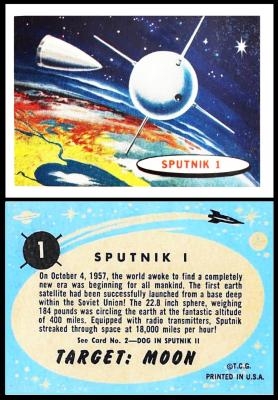
There is a link between Sputnik 1 and the first woman in space as they both started their flights from Baikonur in Kazakhstan (in 1957 and 1963 respectively) .
Sputnik I appears on several cards : the earliest is 1957 Topps "Space", and it is so early that rumour has it the picture came from a leaked document. The name of the craft on the card also contains an error, it says it is Sputnik I (a roman numeral not a number). This had been corrected by the next year, when our card was issued. The first British card of it is Lyons Tea "Space Exploration" (1963) Card 5. Brooke Bond "Race into Space" thought to be the first, was not issued until 1974. The confusion may have arisen because Brooke Bond Canada featured it in their 1969 set "The Space Age".
It has been rather a task to restore this, but it has been fun. And it will continue until it is ready to my satisfaction, although with new information coming in all the time, and my library expanding, these newsletters will never be complete, they will be forever expanding and changing, until the end of the internet, or its replacement with something new.
And who knows, if I have time on my hands I may restore another one.... or more.... some time in the future!
